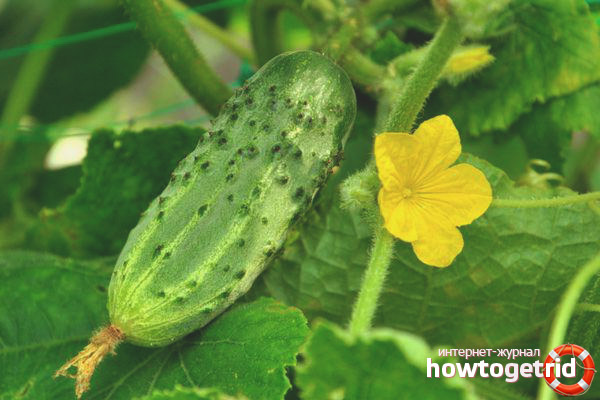The content of the article
Cucumbers are the most popular vegetable crop. With the onset of the season, gardeners try to plant it early in order to taste the fragrant fruits of their labors already at the beginning of summer. Variety Mamenkin pet belongs to the hybrid group. It is characterized by its unpretentiousness to climatic conditions, resistance to common diseases characteristic of representatives of the pumpkin family. A variety is intended for cultivation in greenhouse constructions and on open ground.
Grade characteristics
Breeders got this hybrid when they crossed 2 different varieties. There are few leaves on the bushes, so they do not interfere with the access of light. The fruiting period begins 45 days after sowing the seeds. Bushes are characterized by limited growth and a small number of shoots. Inflorescences are tied in bunches. For the convenience of harvesting and inspection for damage by diseases or pests, plants are tied to an installed vertical trellis.
Self-pollinating variety, great for growing at home. The plants are characterized by a female type of flowering, so the variety is characterized by high yield.
Description of the fruit and their use
The size of the fruit is small. A healthy adult cucumber weighs an average of 90 grams, and has a length of 8 to 10 cm. The skin is light green in color, the surface is slightly ribbed. Spikes of white color are distributed over the entire surface of the peel. Near the nose from the side of the flower there is a small amount of white stripes that do not reach the middle of the cucumber. The taste is sweet, there are no cavities and seeds inside. If the plants are watered and fertilized in a timely manner, then a bitter aftertaste will not be present in the fruits.
Cultivating varieties
Variety Mamenkin pet bred for breeding in different conditions, and therefore the methods of cultivation are different. For example, planting in open ground involves sowing seeds directly into the soil. The time for landing is selected depending on the region and weather conditions. The air temperature during the day should not be lower than +22 degrees, at night - not lower than +16 degrees. Before sowing, seeds must be decontaminated with a weak manganese solution. In order for the sprouts to hatch quickly, the seed is soaked for a day.
When sowing, the distance between neighboring plants must be observed. More dense plantings will prevent the plants from receiving full nutrients, which will adversely affect crop yields. The soil on the beds should be fertile and loose. You can still apply organic fertilizers in the fall, and dig the beds, so the ground will freeze well in the winter.
For cultivating varieties in greenhouse constructions, the seedling method is most often chosen. Planting should be carried out approximately in late April or early May. Unambiguously, the procedure should be carried out after all the frosts are left behind. In the greenhouses, vertical crossbars are installed, to which the lashes of bushes will be tied. This will facilitate the collection of fruits, and save space.
For growing on a windowsill or on a loggia, appropriate conditions should be arranged. It is necessary to provide plants with access to sunlight, if necessary, use additional light sources, as well as to produce regular watering and optimal air temperature.If we allow the drought of the earth or stagnation of water, then the seedlings will begin to hurt and grow poorly, which will negatively affect the harvest.
Care Rules
- Watering. Vegetable crops are very sensitive to soil moisture. In dry weather, watering is recommended every other day. For irrigation use warm, settled water. The manipulation should be in the evening or in the morning before sunrise. Water consumption is about 5-6 liters for one square meter of landings. Do not allow moisture to get on the leaves and shoots. During the beginning of flowering during fruiting, water consumption increases. For cucumbers, it is preferable to choose drip irrigation.
- Loosening. After watering, it is recommended that the soil be loosened so that an earth crust does not form on the surface. Loosening is carried out with caution so as not to damage the root system of plants. In addition, it will help enrich the root system with oxygen. In parallel with loosening, weed must be destroyed. Weeds take nutrients from the earth, and are also carriers of dangerous viruses.
- Top dressing. After the sprouts appear, organic fertilizers must be applied. For this purpose, oven ash or chicken droppings are suitable. During flowering and fruiting, mineral nutrient mixtures should be added. Fertilizers are applied along with watering at the root and spraying the plants. Perform the procedure after sunset.
Diseases and Pests
Despite resistance to various diseases, plants can undergo fungal infections such as powdery mildew or mosaic. And for preventive purposes, special preparations are used to spray the bushes. In order to timely identify signs of the disease, it is necessary to periodically conduct a visual inspection of plants. If affected areas are found, appropriate measures should be taken immediately. Of harmful insects, cucumber webs can harm slugs and aphids. For the fight using proven drugs.
If you follow the cultivation agricultural technique, then you will certainly get excellent quality cucumbers, which will be a good addition to the daily diet.
Video: drip irrigation for growing cucumbers











Submit